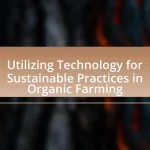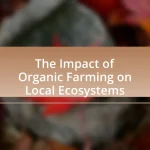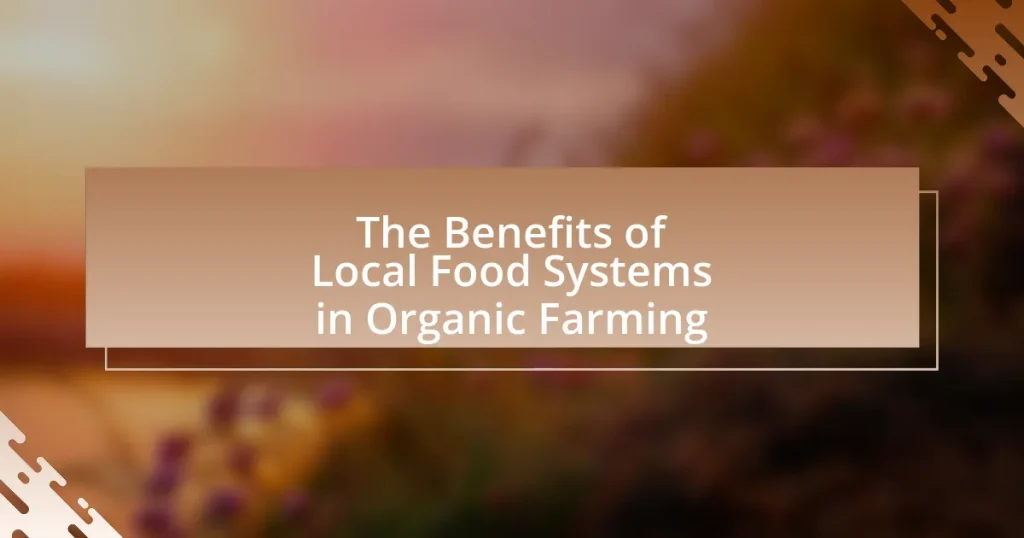Local food systems in organic farming play a crucial role in enhancing sustainability, improving food quality, and fostering community connections. These systems reduce transportation emissions, increase economic resilience for farmers, and promote healthier soil through practices like crop rotation and polyculture. By creating direct market access, local food systems not only boost profitability for organic farmers but also support biodiversity and community engagement. The article explores the various benefits of local food systems, including their impact on economic sustainability, environmental health, and the importance of community support in promoting organic farming practices.
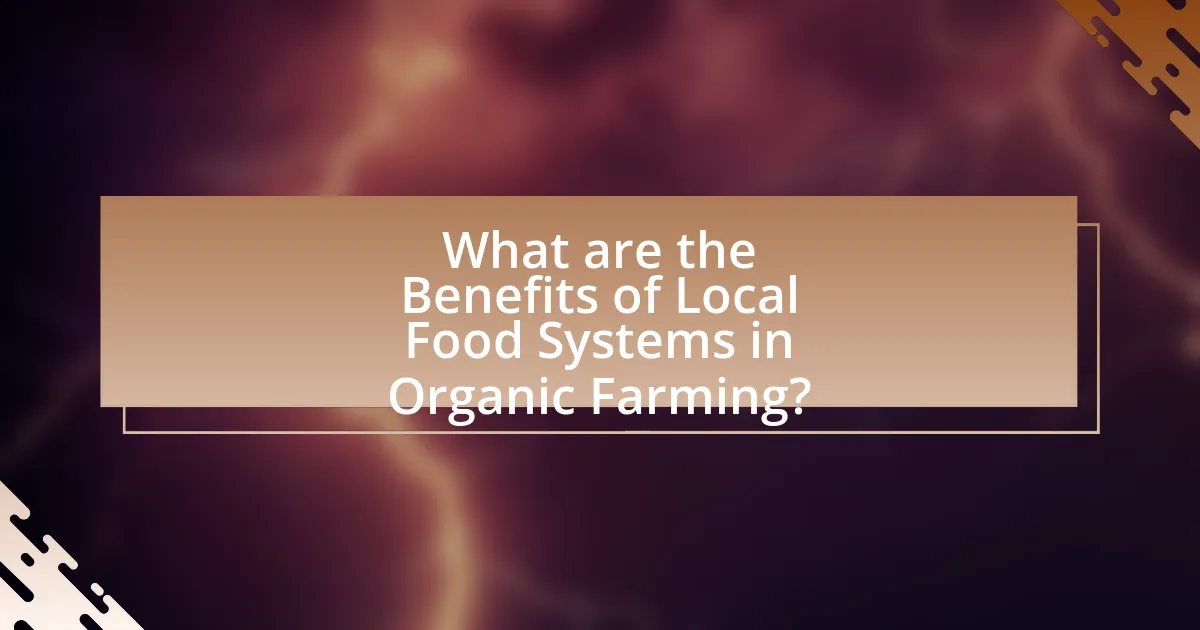
What are the Benefits of Local Food Systems in Organic Farming?
Local food systems in organic farming enhance sustainability, improve food quality, and strengthen community ties. These systems reduce transportation emissions, as food is grown and consumed locally, which contributes to lower carbon footprints. Additionally, local food often retains higher nutritional value due to reduced time from farm to table. Research indicates that local food systems can increase economic resilience by supporting local farmers and keeping money within the community. A study by the USDA found that local food initiatives can lead to a 30% increase in farm income, demonstrating the economic benefits of these systems.
How do local food systems enhance organic farming practices?
Local food systems enhance organic farming practices by creating direct connections between producers and consumers, which fosters sustainable agricultural methods. These systems promote the use of organic practices by providing farmers with immediate market access, reducing transportation costs, and encouraging the sale of locally grown organic produce. Research indicates that local food systems can increase the demand for organic products, as consumers often prefer fresh, locally sourced food, leading to higher prices for organic farmers. Additionally, local food systems support community engagement and education about organic farming, which can further drive the adoption of sustainable practices among new farmers.
What specific advantages do local food systems provide to organic farmers?
Local food systems provide organic farmers with enhanced market access and improved profitability. By selling directly to consumers or local markets, organic farmers can capture a larger share of the retail price, which is often higher than what they would receive through traditional distribution channels. Additionally, local food systems foster community relationships, allowing organic farmers to build a loyal customer base that values sustainable practices. Research indicates that local food sales can increase farm income by 10-30% compared to conventional sales methods, demonstrating the financial benefits of engaging with local markets.
How do local food systems contribute to soil health in organic farming?
Local food systems contribute to soil health in organic farming by promoting biodiversity and enhancing nutrient cycling. These systems often utilize crop rotation and polyculture practices, which improve soil structure and fertility. Research indicates that diverse cropping systems can increase soil organic matter and microbial activity, leading to healthier soils. For example, a study published in the journal “Agriculture, Ecosystems & Environment” found that farms practicing local food systems had significantly higher levels of soil organic carbon compared to conventional farms. This increase in organic matter supports soil health by improving water retention and reducing erosion, ultimately benefiting organic farming practices.
Why is community support important for local food systems in organic farming?
Community support is crucial for local food systems in organic farming because it fosters sustainable practices and enhances food security. When communities actively support local organic farmers, they create a reliable market for their produce, which encourages farmers to adopt environmentally friendly practices. Research indicates that local food systems can reduce carbon footprints by minimizing transportation distances, thereby contributing to climate change mitigation. Additionally, community engagement in local food initiatives strengthens social ties and promotes awareness of healthy eating, which can lead to improved public health outcomes. Studies show that areas with strong community support for local agriculture experience increased access to fresh produce, which is essential for nutrition and well-being.
How does community engagement influence the success of local food systems?
Community engagement significantly enhances the success of local food systems by fostering collaboration, increasing consumer awareness, and promoting sustainable practices. Engaged communities are more likely to support local farmers, participate in farmers’ markets, and advocate for policies that benefit local agriculture. Research indicates that areas with strong community ties see a 30% increase in local food purchases, demonstrating the direct correlation between community involvement and economic support for local food systems. Furthermore, community engagement leads to shared knowledge and resources, which can improve agricultural practices and sustainability efforts, ultimately contributing to the resilience and viability of local food systems.
What role do local consumers play in supporting organic farmers?
Local consumers play a crucial role in supporting organic farmers by providing a direct market for their products, which helps sustain their livelihoods. When consumers choose to buy organic produce from local farmers, they contribute to the economic viability of these farms, enabling farmers to continue their sustainable practices. According to a study by the USDA, local food systems can increase farm income by up to 30% compared to traditional distribution methods, demonstrating the financial impact of consumer choices on organic farming. Additionally, local consumers often prioritize fresh, seasonal produce, which encourages organic farmers to grow a diverse range of crops, further enhancing local food systems and promoting biodiversity.
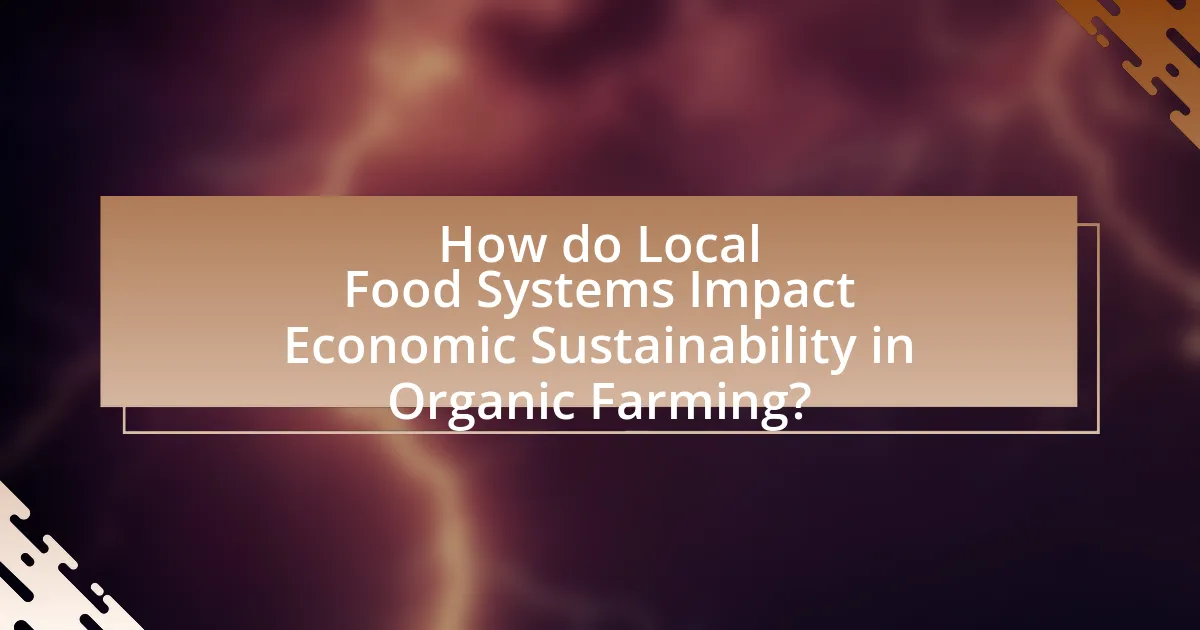
How do Local Food Systems Impact Economic Sustainability in Organic Farming?
Local food systems enhance economic sustainability in organic farming by creating direct market access for farmers, which increases their profitability. By selling directly to consumers, farmers can retain a larger share of the retail price, reducing reliance on intermediaries. Research indicates that local food systems can lead to a 30-50% increase in farm income compared to conventional distribution methods. Additionally, these systems foster community engagement and support local economies, as consumers are more likely to purchase from nearby farms, thereby circulating money within the local economy. This localized approach not only strengthens the financial viability of organic farms but also promotes sustainable agricultural practices that benefit the environment and community health.
What economic benefits do local food systems offer to organic farmers?
Local food systems provide significant economic benefits to organic farmers by enhancing their market access and increasing profitability. By selling directly to consumers through farmers’ markets, community-supported agriculture (CSA), and local restaurants, organic farmers can capture a larger share of the retail price, often resulting in higher income compared to traditional distribution channels. Research indicates that direct sales can yield up to 50% more revenue for farmers compared to wholesale prices. Additionally, local food systems foster community support, leading to increased customer loyalty and repeat business, which further stabilizes income for organic farmers.
How do local food systems reduce transportation costs for organic produce?
Local food systems reduce transportation costs for organic produce by minimizing the distance between producers and consumers. This proximity decreases fuel expenses and logistical complexities associated with long-distance shipping. For instance, a study by the USDA found that local food systems can cut transportation costs by up to 50% compared to conventional supply chains, as shorter routes require less fuel and fewer handling processes. Additionally, local markets often facilitate direct sales from farmers to consumers, eliminating intermediaries and further lowering costs.
What is the impact of local food systems on pricing for organic products?
Local food systems generally lead to lower prices for organic products due to reduced transportation costs and direct sales from producers to consumers. By minimizing the supply chain, local food systems eliminate intermediaries, which can significantly decrease the final retail price. For instance, a study by the USDA found that local organic produce can be priced 10-30% lower than similar products distributed through conventional channels, as local farmers often sell directly at farmers’ markets or through community-supported agriculture (CSA) programs. This direct connection not only reduces costs but also enhances the freshness and quality of organic products, making them more appealing to consumers.
How do local food systems create job opportunities in organic farming?
Local food systems create job opportunities in organic farming by fostering direct connections between consumers and producers, which increases demand for locally grown organic products. This demand leads to the establishment and expansion of organic farms, requiring more labor for planting, harvesting, and distribution. According to a study by the USDA, local food systems can generate up to 13 jobs for every $1 million in sales, highlighting the significant employment potential in organic farming. Additionally, local food initiatives often support community-based programs that provide training and resources for new farmers, further enhancing job creation in the sector.
What types of jobs are generated through local food systems?
Local food systems generate a variety of jobs, including positions in farming, food processing, distribution, retail, and marketing. Specifically, these jobs encompass roles such as farmers, agricultural workers, food artisans, delivery drivers, and store employees in local markets. According to a report by the USDA, local food systems can create up to 13 jobs for every $1 million in sales, highlighting their significant impact on employment. Additionally, local food initiatives often lead to the development of community-supported agriculture (CSA) programs, which further contribute to job creation in local economies.
How do these jobs contribute to local economies?
Jobs in local food systems, particularly in organic farming, contribute to local economies by creating employment opportunities and stimulating local spending. These jobs often include positions such as farmers, processors, and distributors, which directly employ community members. According to a study by the USDA, local food systems can generate up to 13 jobs for every $1 million in sales, significantly boosting local employment rates. Additionally, when consumers purchase locally produced organic food, they tend to spend more within their communities, which enhances local businesses and services. This cycle of employment and spending fosters economic resilience and growth in local economies.
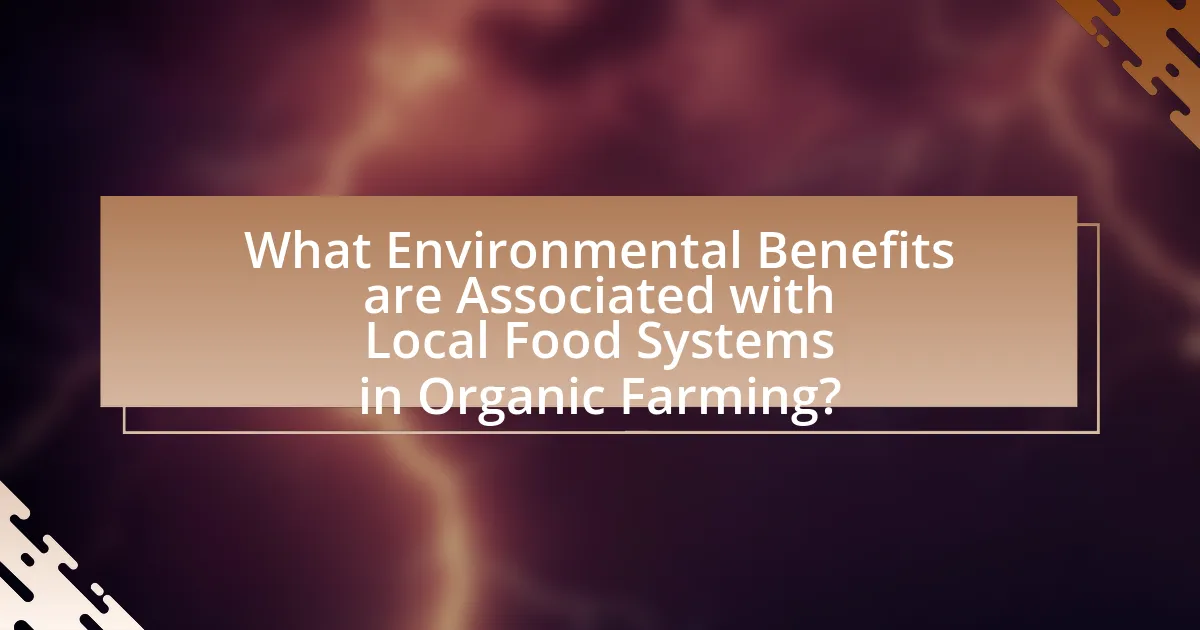
What Environmental Benefits are Associated with Local Food Systems in Organic Farming?
Local food systems in organic farming provide significant environmental benefits, including reduced greenhouse gas emissions, enhanced biodiversity, and improved soil health. By sourcing food locally, transportation distances are minimized, which lowers carbon emissions associated with food transport. Studies indicate that local food systems can reduce emissions by up to 50% compared to conventional food systems. Additionally, organic farming practices promote biodiversity by avoiding synthetic pesticides and fertilizers, which can harm non-target species. Research shows that organic farms support a higher diversity of plants and animals, contributing to ecosystem resilience. Furthermore, organic farming enhances soil health through practices like crop rotation and cover cropping, which improve soil structure and fertility. This leads to better water retention and reduced erosion, as evidenced by findings from the Rodale Institute, which highlight the long-term benefits of organic practices on soil quality.
How do local food systems promote biodiversity in organic farming?
Local food systems promote biodiversity in organic farming by encouraging diverse crop rotations and the cultivation of native species. These systems prioritize local varieties that are better adapted to regional conditions, which enhances genetic diversity. Research indicates that farms engaged in local food systems often utilize polyculture practices, leading to a greater variety of plants and animals, which supports ecosystem resilience. For instance, a study published in the journal “Agriculture, Ecosystems & Environment” found that farms with diverse cropping systems had higher levels of beneficial insects and soil health, demonstrating the positive impact of local food systems on biodiversity.
What practices within local food systems support biodiversity?
Practices within local food systems that support biodiversity include crop rotation, polyculture, and organic farming techniques. Crop rotation enhances soil health and reduces pest populations by alternating different crops, which disrupts pest life cycles and promotes a diverse ecosystem. Polyculture, the practice of growing multiple crops in the same space, increases resilience against pests and diseases while fostering a variety of habitats for beneficial organisms. Organic farming techniques, such as the use of compost and natural pest control methods, further contribute to biodiversity by avoiding synthetic chemicals that can harm non-target species. These practices collectively create a more balanced ecosystem, supporting a wide range of plant and animal life.
How does biodiversity affect the resilience of organic farms?
Biodiversity enhances the resilience of organic farms by promoting ecosystem stability and reducing vulnerability to pests and diseases. A diverse range of species contributes to a balanced ecosystem, which can better withstand environmental stressors such as climate change and extreme weather events. Research indicates that farms with higher biodiversity experience lower pest outbreaks and improved soil health, leading to increased crop yields. For instance, a study published in “Nature” by Isbell et al. (2011) found that biodiversity loss can reduce ecosystem productivity by up to 50%, highlighting the critical role of diverse species in maintaining farm resilience.
What role do local food systems play in reducing carbon footprints?
Local food systems significantly reduce carbon footprints by minimizing transportation distances and promoting sustainable agricultural practices. When food is sourced locally, it typically travels shorter distances from farm to consumer, which decreases greenhouse gas emissions associated with transportation. For instance, a study by the USDA found that food transported over long distances can generate up to 11 times more carbon emissions than locally sourced food. Additionally, local food systems often emphasize organic farming methods that avoid synthetic fertilizers and pesticides, further lowering carbon emissions and enhancing soil health. This combination of reduced transportation and sustainable farming practices makes local food systems a crucial component in efforts to mitigate climate change.
How does local sourcing of food minimize transportation emissions?
Local sourcing of food minimizes transportation emissions by significantly reducing the distance food travels from farm to consumer. When food is sourced locally, it typically requires less fuel for transportation, which directly correlates to lower greenhouse gas emissions. For instance, a study by the USDA found that food transported over long distances can generate up to 11 times more carbon dioxide emissions compared to locally sourced food. This reduction in travel distance not only cuts down on fossil fuel consumption but also lessens the overall carbon footprint associated with food distribution.
What are the long-term environmental impacts of local food systems?
Local food systems have several long-term environmental impacts, primarily including reduced greenhouse gas emissions, enhanced biodiversity, and improved soil health. By shortening the supply chain, local food systems minimize transportation distances, which significantly lowers carbon emissions associated with food transport. Research indicates that food produced and consumed locally can reduce emissions by up to 50% compared to conventional systems.
Additionally, local food systems often promote sustainable agricultural practices that support biodiversity. For instance, organic farming methods, commonly associated with local food systems, encourage crop rotation and polyculture, which enhance ecosystem resilience and protect native species. Studies show that farms practicing these methods can increase species richness by 30% compared to conventional monoculture farms.
Furthermore, local food systems contribute to improved soil health through practices such as composting and reduced chemical inputs. Healthier soils lead to better water retention and reduced erosion, which are critical for long-term agricultural sustainability. Research from the Rodale Institute highlights that organic farming can improve soil organic matter by 22% over a five-year period, enhancing soil fertility and structure.
In summary, local food systems positively impact the environment by reducing emissions, promoting biodiversity, and improving soil health, supported by various studies and research findings.
What are the best practices for implementing local food systems in organic farming?
The best practices for implementing local food systems in organic farming include establishing direct relationships between farmers and consumers, promoting community-supported agriculture (CSA), and utilizing local resources for production and distribution. Direct relationships enhance transparency and trust, allowing consumers to understand the origins of their food. Community-supported agriculture fosters a partnership where consumers buy shares of the harvest, providing farmers with upfront capital and ensuring a market for their produce. Utilizing local resources, such as soil and climate-specific practices, optimizes production and reduces transportation emissions, contributing to sustainability. These practices are supported by studies showing that local food systems can increase farm profitability and community resilience, as evidenced by research from the USDA that highlights the economic benefits of local food initiatives.
How can farmers effectively connect with local consumers?
Farmers can effectively connect with local consumers by participating in farmers’ markets and community-supported agriculture (CSA) programs. These platforms allow farmers to sell their products directly to consumers, fostering relationships and trust. Research indicates that direct sales through farmers’ markets can increase farmers’ income by up to 40% compared to traditional retail channels. Additionally, engaging with local consumers through social media and farm tours can enhance visibility and create a sense of community, further solidifying the connection between farmers and consumers.
What strategies can be employed to strengthen local food networks?
To strengthen local food networks, strategies such as enhancing collaboration among local producers, establishing community-supported agriculture (CSA) programs, and promoting local food education can be employed. Collaboration among local producers fosters relationships that can lead to shared resources, knowledge exchange, and collective marketing efforts, which have been shown to increase sales and visibility for small farms. Community-supported agriculture programs create direct connections between consumers and farmers, ensuring that local produce is prioritized and reducing reliance on distant supply chains. Additionally, promoting local food education through workshops and outreach initiatives raises awareness about the benefits of local food systems, encouraging community engagement and support for local agriculture. These strategies collectively contribute to a more resilient and sustainable local food network.



